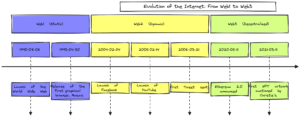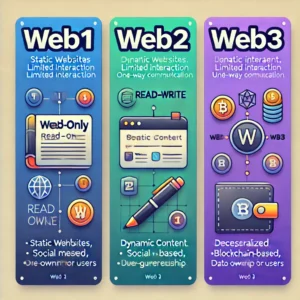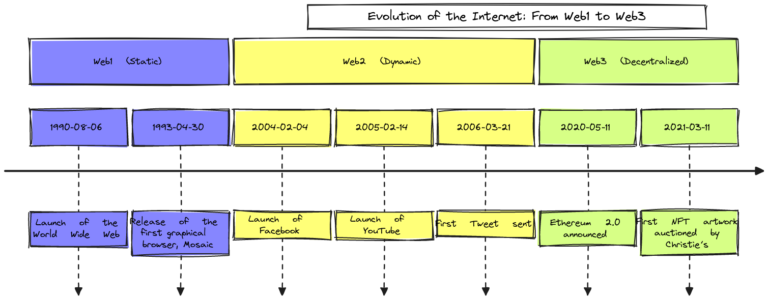Introduction
The internet has transformed the way we live, work, and interact. From the static and limited Web1 to the dynamic and user-centric Web2, and now the decentralized and empowering Web3, the journey of the internet showcases the remarkable potential of innovation.
In this blog, we’ll explore:
-
- The history of the web: Web1 → Web2 → Web3.
- How each phase evolved.
- Why Web3 is considered the future of the internet.
Visual Overview: Internet Evolution Timeline

This timeline highlights the major milestones in the evolution of the internet:
-
- Web1 (Static): 1990s – Early websites like Mosaic and GeoCities.
- Web2 (Dynamic): 2000s – The era of social media, YouTube, and dynamic content.
- Web3 (Decentralized): 2020s – Blockchain, smart contracts, and digital ownership.
Web1: The Static Web
-
-
Era: Early 1990s to early 2000s.
-
Overview:
Web1, often called the “read-only web”, introduced the internet as a global source of information. Websites were static, offering information without interactivity. Users could only consume content. -
Key Characteristics:
- Static HTML pages.
- No logins, commenting, or personalization.
- Developer-controlled content.
-
Key Milestones:
- 1990: Launch of the World Wide Web by Tim Berners-Lee.
- 1993: Release of Mosaic, the first graphical browser.
-
Limitations:
- Lack of interactivity.
- Minimal collaboration opportunities.
-
Web2: The Dynamic and Social Web
-
Era: Early 2000s to Present.
-
Overview:
Known as the “read-write web”, Web2 allowed users to engage with content. Platforms like Facebook, YouTube, and Wikipedia enabled user-generated content and interaction. However, the era also introduced challenges like data centralization and privacy concerns. -
Key Characteristics:
- Centralized platforms dominate.
- APIs enable seamless app integration.
- Monetization relies heavily on user data and ads.
-
Key Milestones:
- 2004: Launch of Facebook.
- 2005: Launch of YouTube.
- 2006: The first Tweet is sent on Twitter.
-
Challenges:
- Over-reliance on centralized platforms.
- Concerns over data privacy and user control.
Web3: The Decentralized Web
-
Era: Emerging Now.
-
Overview:
The “read-write-own web” marks a shift from centralized platforms to decentralized networks powered by blockchain. Users now have ownership of their data and digital assets, and intermediaries are reduced or removed entirely. -
Key Characteristics:
- Decentralized applications (dApps).
- Digital ownership via NFTs and cryptographic tokens.
- Community-driven governance via DAOs.
-
Key Milestones:
- 2020: Ethereum 2.0 announced to scale decentralized networks.
- 2021: First NFT artwork auctioned by Christie’s for $69 million.
-
Advantages:
- Ownership and privacy.
- Decentralized infrastructure ensures transparency.
Web1 vs. Web2 vs. Web3: Key Differences
| Aspect | Web1 | Web2 | Web3 |
|---|---|---|---|
| Interactivity | Read-only | Read-write | Read-write-own |
| Ownership | Developers only | Platform-controlled | User-controlled |
| Examples | GeoCities | Facebook, YouTube | OpenSea, Uniswap |

Why Web3 is a Game-Changer
- Decentralization:
Reduces reliance on centralized platforms and empowers users. - Transparency and Security:
Blockchain ensures open, secure, and auditable systems. - User Ownership:
Individuals own their data, assets, and digital identities.
Conclusion
The evolution from Web1 to Web3 reflects the growing importance of ownership, transparency, and user empowerment. Web3 represents not just a technological shift but a philosophical one—returning control to users in a decentralized and inclusive internet.


